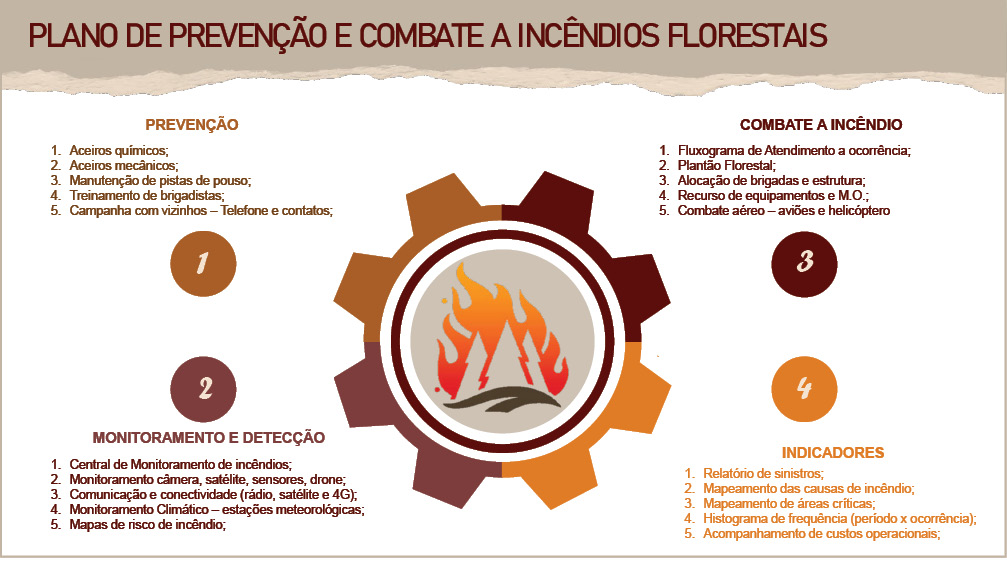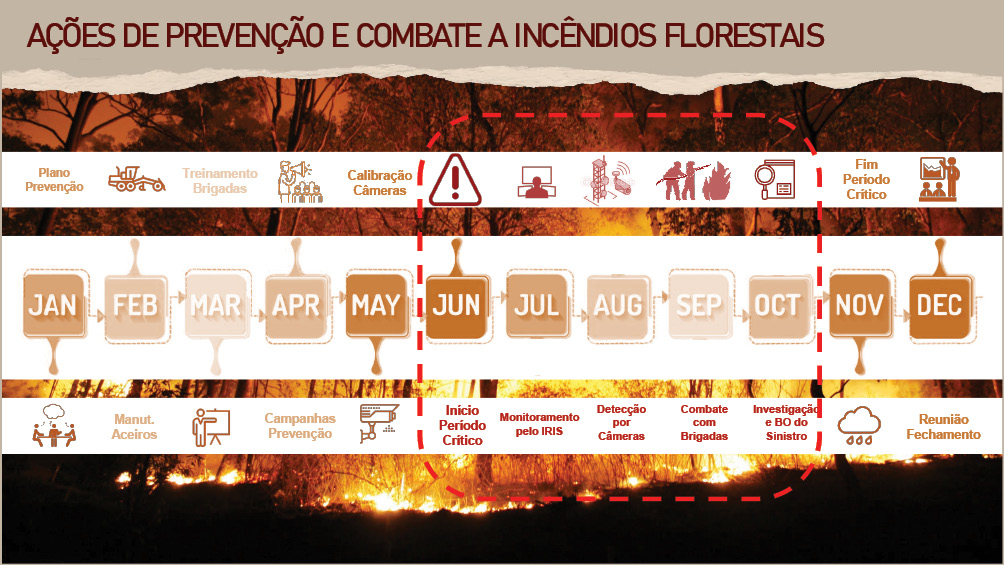Jozébio Esteves Gomes
Competitiveness and Projects Coordinator Florestais of Eldorado Brasil Celulose
OpCP70
Zero fire!
The great dilemma for most forest-based companies in the world has always been to avoid loss and damage to their forestry assets caused by fire. The question that always comes to the table when working with fire prevention and fighting plans is: how to reach the goal of zero fire without damage to forestry assets? We know how difficult the predictability of this metric is, since the sources and causes of fires in forest stands are diverse and, in some cases, even unknown.
However, in recent years, global concerns, mainly with the environment and carbon dioxide emissions, have been pressing more and more governments and organizations to act more effectively, in an attempt to minimize the impacts caused by undesirable fires, which leads to the development of new protection processes, new technologies and devices capable of virtually guaranteeing the predictability and assertiveness of monitoring and detection and improving the effectiveness of fighting fires.

However, the cost of preventing and combating damage to forest assets as much as possible is still high and significant for governments, companies and institutions. Hence the need to dedicate more intelligence to prevention actions, so that they allow for an increasingly efficient fight and contribute to the implementation of disruptive and even innovative technologies, aimed exclusively at protection activities against forest fires.
Of course, these technologies and innovations still do not replace the classic and established conventional forest protection practices when it comes to fire. Having an intelligently structured forest fire prevention and combat plan that can be efficiently applied is a major competitive advantage in preventing damage to forest assets, reducing business risks and even adding environmental value to initiatives to sustainability of companies.
 Generally, an intelligent prevention plan is anchored on 4 fundamental pillars: prevention, monitoring, detection, firefighting and intelligence indicators, as shown in the Forest Fire Prevention Plan chart. Intelligent prevention brings together all the good practices that precede the critical period so that all other stages of the prevention plan are efficiently and successfully executed. At this stage, the firebreaks, airstrips and roads have to be revisited and maintained, so that they are fully usable during the processes of combating existing outbreaks.
Generally, an intelligent prevention plan is anchored on 4 fundamental pillars: prevention, monitoring, detection, firefighting and intelligence indicators, as shown in the Forest Fire Prevention Plan chart. Intelligent prevention brings together all the good practices that precede the critical period so that all other stages of the prevention plan are efficiently and successfully executed. At this stage, the firebreaks, airstrips and roads have to be revisited and maintained, so that they are fully usable during the processes of combating existing outbreaks.
It is also at this stage that the brigade members must be trained and requalified annually, as a guarantee that no one will go to the front of the fire without proper combat practice and knowledge, avoiding the risk of accidents and even the loss of human lives. Another important point at this stage are the campaigns to disseminate useful information and awareness about the risks and damage caused by fire, which applies to communities, neighbors and partners, as they are the ones who, in a time of crisis, will be able to provide any kind of support monitoring, detection and even the practice of combating existing outbreaks.
Intelligent monitoring houses technology and innovation. With powerful detection systems equipped with artificial intelligence, current monitoring centers are capable of detecting up to 30 simultaneous outbreaks of fires in real time. This is possible thanks to the technological power embedded in the monitoring towers in the field, where we have cameras with high vision capacity, equipped with light, thermal and infrared sensors, which are able to capture, instantly, any anomalies in forest stands, as shown the Intelligent Monitoring and Detection Center of Eldorado Brasil.
Still within the monitoring and intelligent detection of fire occurrences, the complementary monitoring stands out, which rely on the use of satellites, sensors and the most recent novelty in the market, unmanned long-range aircraft, with autonomy above 6 hours of flight, which allow, in addition to real-time monitoring, assisted combat, supporting fundamental decision-making for the effectiveness of fire suppression.
Another important point considered in intelligent monitoring is the predictability associated with climate monitoring, which allow for anticipation and knowledge of risks to forestry assets in the event of fire. To this end, today, there are high -performance systems and algorithms specialized in processing climate information, which instantly release information on fire risks with precision in a given region, also generating maps of future risks.
Efficient combat is extremely important for the success of the intelligent prevention plan. It is at this stage that every action will provoke an effective reaction to suppress fundamental fire outbreaks. It is fundamental, in this phase, the existence of a flowchart that expresses, in a simple, clear and efficient way, how the occurrences will be attended, so that the combat teams can be dispatched quickly.
Also at this stage, the routine of the forestry duty is important, for the dispatch of brigade members, equipment and support structures, as well as the dispatch of combat aircraft (planes and helicopters). To this end, it is important to emphasize that all resources intended for combat must be strategically allocated, reducing the time between the dispatch and the start of combating occurrences, optimizing structure, reducing costs and increasing combat efficiency, avoiding as much as possible any damage caused to forest assets as shown in the table in the Plan for the Prevention and Combat of Forest Fires, highlighted.
Finally, we have the pillar of Intelligence Indicators, which are extremely important so that we can rely on robust analyzes of the information obtained during the cycle of preventing and combating fire occurrences. The mission is to support and evaluate the strategies adopted, as well as to propose the insertion of new actions in view of opportunities for improvements that promote the achievement of the goal of zero fires, in addition to mapping the causes of fires and their respective critical areas. This initiative generates a histogram of the frequency of critical periods that require greater attention for intelligent prevention with effective combat within organizations.

Despite everything, the correct application of intelligent prevention (with efficient combat) to obtain results that lead to zero fires in organizations depend, in their entirety, on qualified, committed people, with knowledge and experience focused on the safety of employees, the protection of forest assets and respect for the environment, contributing to a sustainable production practice, minimizing risks, reducing costs and maximizing positive results for forest-based companies.




